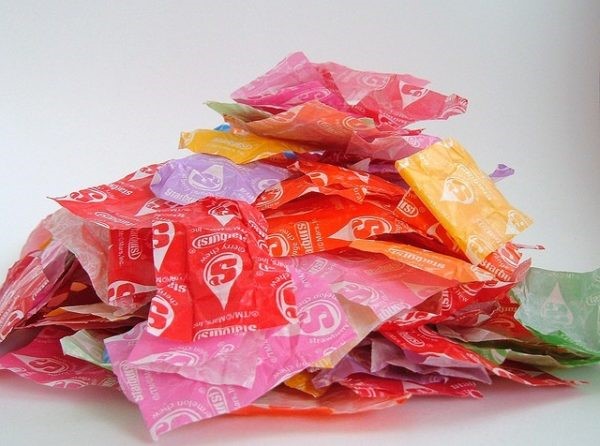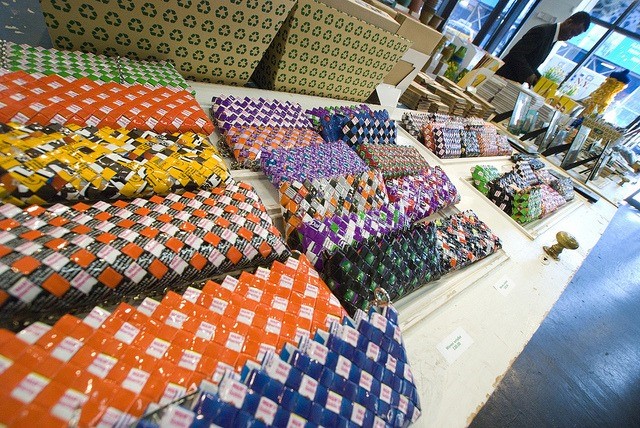Source: earth911.com
Published: October 20, 2012

You’ve got a sweet tooth you need to satisfy, but did you know that most of our favorite candies are wrapped in what has somehow become the unwanted stepchildren of waste management? Tossed in the trash or in a recycle bin, all candy wrappers make their way to the landfill. But why is this small, colorful package so seemingly difficult to recycle?
The above paragraph no longer exists at the source above. The following update is now featured there.

‘Tis the season for candy, candy and more candy. Pumpkin-shaped chocolates, sour gummies, sugary sweet lollipops and tons of other sweet treats line the shelves at the grocery store this time of year. My sweet tooth is calling, but does the planet approve?
Most of our favorite candies are wrapped in not-so-eco-friendly materials that make their way into the landfill, even when dutifully placed in the recycling bin. These colorful little wrappers are simply too difficult to recycle.
Waste management specialists have come to one conclusion: It’s just not worth it. Unlike materials America readily recycles, like glass bottles and aluminum cans, wrappers are typically made of multiple materials. Bits of plastic, aluminum and paper are mixed together, making it difficult, tedious and expensive to recover each constituent for recycling.
Packaging consultant Sterling Anthony says it all comes down to the state of the recyclable materials market.
“PET plastic, the plastic used for most water and soft drinks, is made from one material, and that material can be broken down into materials that can be used for other items. So, there’s a market for it,” Anthony says.
Because plastic bottles can be recovered easily and economically, and there’s a healthy end-use market for their recovered materials, waste management facilities have an incentive for their collection and processing. However, candy wrappers are usually made up of mixed materials, making the recovery of useful materials difficult and expensive.
As a result, most waste management companies, manufacturers and municipal recycling facilities tend to turn their backs from candy wrappers.
The Volume Dilemma
While a healthy market for recovered candy wrappers may be in our reach, Anthony says the The response from the market is in full support of the new eco-friendly candy packaging. Now, Rodenburg is hoping that Mars will take their project to the U.S.
“Infrastructure always follows volume,” he says. “If volume is not great enough, there’s not an economic incentive.”
The amount of waste generated by candy wrappers doesn’t match up to things like glass, paper and aluminum cans, which have a high presence in our waste stream and are thus almost always recycled. Waste management organizations are looking to get the bang for their buck when it comes to recyclables, and candy wrappers just don’t make the cut.
A Greener Package
Volume is a legitimate concern, but how can I satisfy my sweet tooth and save the planet at the same time?
An innovative company is finding a solution. Rodenburg Biopolymers is a family-owned business in the Netherlands leading the biopolymer industry. Rodenburg partners with various companies — like manufacturers and retailers — to develop biodegradable compounds for their products.
The geniuses behind one of our favorite candies, Mars (among other treats; you can thank them for ever-so-scrumptious M&Ms), partnered with Rodenburg to develop a bio-based packaging solution for their candies.
The project resulted in a food-grade polymer film compound called Solanyl. It is biodegradable, compostable and uses only a third of the energy oil-based materials — what candy wrappers are typically made of — use.
Snickers, another Mars product, made their eco-friendly European debut in 2016, and Rodenburg is dedicated to making sure more candies follow suit.
The response from the market is in full support of the new eco-friendly candy packaging. Now, Rodenburg is hoping that Mars will take their project to the U.S.
A Sweet Alternative

Candy wrappers can be upcycled into consumer products such as laptop sleeves Photo: Flickr/Dave Pinter
Creative folks have thought of all kinds of ways to repurpose candy wrappers. A quick search on the Internet for items made out of candy wrappers will generate page after page of handbags, wallets and even candy-wrapper jewelry.
Eco-conscious company TerraCycle can help you reduce your candy-wrapper-waste with their Zero Waste Box. Simply order the box, collect the waste, and ship it back to TerraCycle for recycling. TerraCycle will make sure it gets to where it needs to go.
The collected wrappers will be separated into their myriad of fibers and plastics. The fibers can then be either composted or recycled and the plastics are used to make new products.
Without TerraCycle, these wrappers would all end up in the landfill, polluting our planet.
Next time you reach for that sweet treat, think of the life cycle of that piece of candy. You don’t need to hold back — just plan to upcycle or recycle your wrappers.
Feature photo:Emily O’Chiu
This article was originally written by Becky Hammad on May 18, 2009.It was updated by Lauren Murphy on Oct.20, 2017.
